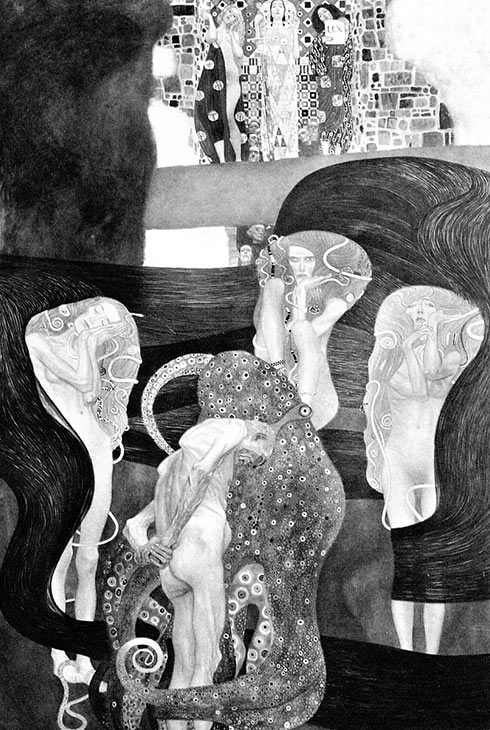The Jurisprudence is a collection of a series of paintings created by Gustav Klimt for the ceiling of the University of Vienna's Great Hall between 1900 - 1907.
These paintings were met with an immense amount of criticism as the work's sexual nature were seen as pornographic. None of the paintings will go on display in the university, and were eventually burned in 1945 by German Officers.
The imagery within the Jurisprudence showcase women engulfed under the water in a sea world. There are three prominent women from the piece, with long hair that flows beneath their shoulders, and mixes with the water around. The painting illustrates these three nude women holding their arms against her face, as they slip under the deep blue sea.
Behind the women, dark black swirls are showcased through the textures of the piece. These swirls mix with the woman's hair throughout the currents of the water. A dark black octopus seizes have the hands of a naked man, holding his face towards the ground. The octopus is not seen in color, however is covered in the mosaic pattern that the artist used throughout many of his pieces.
Near the top of the painting, a triple entente of women are located dressed in different coloured clothes. The middle woman seems to be of Japanese dissent, standing with a halo around her head and her arms raised above. She is clothed in an upside down triangle pattern cloth that flows towards her legs. The woman to her right seems to be of African-American descent holding a book within her hands and staring directly at the viewer.
The woman is closed in a black and white pattern that flows and small white circles. The woman to the left of the painting is nude and covers her breast with her arms. The woman has blonde curly hair, and seems to be of Aryan decent, rather than the classic Austrian features Klimt used at the time. Behind the triple entente of women, a mosaic pattern of different styles, swirls, all shaped together creating one art piece.
The painting is filled with a dark emotion through every turn with the artwork. The octopus within the painting is seen to have seized the male, leaving the women to be frightened.
Even though the painting is a classic piece of Klimt's work, the darker emotion and philosophy behind the prize shows a different feel than many of his contemporaries of the time.
The piece will never be displayed in the University of Vienna as it is seen as a pornographic piece that exploits the female body in the barbaric form as it connects with sea creatures. Similar pieces such as Medicine are seem to be excessively sexual and were not used within the Great Hall.
This piece holds a sense of philosophy behind it, as it connects nature with the great blue sea creatures at the time. The dark textures behind the piece holds as a symbol that illustrates a darker emotion behind the work. The swirling textures, and styles throughout the piece illustrate the art nouveau style.




